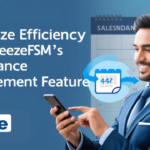- Breeze FSM
- 0 Comments
- 1451 Views
In the fast-paced world of field sales, managing meetings, following up on leads, and tracking performance can be overwhelming. Scheduling meetings efficiently is crucial to avoid missing opportunities. A sales meeting scheduler simplifies the process, reducing the back-and-forth communication, so no potential deal slips through the cracks.
In this blog, we try to figure out exactly what a sales meeting scheduler is, what free tools exist in the market, how to use them effectively, and how they help field sales managers become more efficient.
Streamline, Optimize, and Succeed with BreezeFSM
- AI-powered Market Assistant
- Territory Mapping
- Activity Tracking
- Capturing and tracking leads
- Performance Insight
What is a Sales Meeting Scheduler?
A sales meeting scheduler is a tool that’s designed to make it easier for one to schedule and manage meetings. It will integrate with your calendar and communication tools, thereby enabling you to set up meetings, send invites, get RSVPs, and manage reminders from one spot. In field sales managers, a scheduler can optimize daily schedules, reduce no-shows, and ensure time is utilized to maximum productive value.
Why a Sales Meeting Scheduler is Important for Field Sales Managers
Saves Time: Automates the process of scheduling that saves lots of time spent on back-and-forth emails and phone calls to set up meetings.
Improves Productivity: Allows managers to focus on high-value activities related to strategy planning and nurturing leads rather than administrative tasks.
Reduces No-Shows: Automated reminders sent to both sales representatives and clients ensure that meetings are never forgotten.
Improves Customer Experience: The clients face no friction while scheduling, hence providing way better relationships with clients.
Free Sales Meeting Scheduler Tools Available in the Market
There are a few free tools that can be used effectively as a lead magnet, and increase the productivity of field sales managers. Some of the best among them are:
1. Calendly
Overview: Calendly is a popular meeting-scheduling tool integrated with major calendar services like Google Calendar, Outlook, and iCal. It allows the users to set their availability and share with them a booking link that can be used by clients or colleagues.
Features:
- Unlimited one-on-one meetings.
- Automatic meeting reminders.
- Time zone detection.
- Meeting type creation-15 and 30-minute time slots.
How to Use: With Calendly, sales managers can create unique booking links for various meeting types, such as initial consultation, follow-up, and more. The client will then have the option to choose a time slot that best suits them from their manager’s availability, hence reducing scheduling conflicts and no-shows.
Efficiency Tips: Reduce no-shows by utilizing automated reminders with Calendly. Then, connect it with your CRM to log meetings and follow-ups automatically.
2. Google Calendar
Overview: Google Calendar is a multi-dimensional tool used in personal and professional life. For sales meeting scheduling, it can be extended by several add-ons such as CalendarHero or Meetingbird.
Key Features:
- Syncs across devices.
- Scheduling across multiple calendars.
- Set reminders and notifications.
How to Use: Using Google Calendar, sales managers can create an event and send an invite directly to a client or team member. Integrate Google Calendar with tools like “CalendarHero” and automate your scheduling so you won’t have any double-booking.
Efficiency Tips: Allow shared calendar access to team members in view of each other’s availability and for easier meeting planning.
3. HubSpot Meeting Scheduler
Overview: HubSpot provides a free meeting scheduler inside its CRM. By the name, it seems that this tool is specially designed for sales teams so they can schedule meetings right from within the CRM itself. It provides the following features:
- It syncs up with Google and Office 365 calendars.
- It allows your link to create a meeting.
- The meeting will be logged automatically inside the CRM system.
- Booking pages and form fields can be customized.
How it works: Once your calendar and HubSpot are integrated, you can create a personal booking link to send over to prospects and clients. Automatically log meetings within CRM for end-to-end convenience from scheduling through follow-up.
Efficiency Tips: Make use of the CRM integration to track all interactions and follow-ups to ensure leads aren’t missed.
4. Microsoft Bookings
Overview: Microsoft Bookings is a part of the suite for Microsoft 365, which allows smooth appointment scheduling and management. Features to be considered: Customizable booking page Smyncs with Microsoft Outlook calendar Automated email and SMS reminders Option to integrate with Microsoft Teams for virtual meetings
How to Use: Just set up a booking page with your time slots available and share them with your clients. Microsoft Bookings will automatically handle all confirmations, reschedules, and cancellations while syncing everything with your Outlook calendar.
This saves time and effort as it integrates well with Microsoft Teams. You can virtually take any scheduled meeting if necessary.
5. Setmore
Overview: Setmore is an online appointment scheduler that suits small teams, so it offers a free plan too.
Among the features are:
- Unlimited Appointments
- Customizable Booking Page
- Integration with Popular Calendars and Payment Gateways
- Automated Email Alerts.
How it works: One creates a booking page, and then shares that with the website or social media profiles. Setmore handles all incoming bookings, reminders, and updates to your calendar.
Efficiency tips: Use the integrated payment feature to collect deposits or fees up-front, reducing cancellations and increasing commitment to the meeting.
How to Efficiently Leverage Sales Meeting Schedulers
How to make the most of a sales meeting scheduler? Some hints here will help: Set Clear Availability: Keep your calendar updated to indicate the time slots when you are available. Block times for internal meetings, personal commitments, and focused work.
Customizing Meeting Types: Establish meeting types according to time and purpose; for example, first consultation, follow-up, or demonstration. This guides the client in booking the appropriate type of meeting so that sufficient time is allocated.
Integrate with Your CRM: Most meeting schedulers allow integrations with CRMs. Use this for automatically logging meetings, calls, follow-ups, and give a 360-degree view into client interaction and sales activities.
Automate Reminders and Follow-ups: Set up automatic reminders to avoid no-shows and keep follow-up calls or emails to a minimum. This saves not only your time but also ensures that the meetings happen at the right time.
Data Insights: Check out the data coming from your scheduler, which could denote trends of peak times of booking, most rescheduled meetings amongst others. Use such insight to optimize your availability for more client engagement.
Embed Scheduler in Website and Emails: Let your clients make an appointment with a minimum of clicks by embedding the scheduler link within your email signature, on your website, and social media profiles. This way, the potential clients have no extra hassle to find the scheduler.
Encourage Self-Scheduling: Enable clients to schedule meetings at their convenience. This saves them time without having to go through back-and-forth communications; this empowerment of feeling in control will enhance their experience.
Review and Adjust Your Scheduler Settings Periodically: Go through your settings in the scheduler once in a while to see if they still serve you and your clients best. Adjust meeting types, available times, and reminder settings as necessary to achieve optimal results.
Conclusion
This will be a powerful tool for field sales managers since it will help systemize their task of scheduling by saving time and enhancing productivity. A sales manager who gets the perfect tool and puts its usage in place can only focus on selling rather than being caught up with much administrative work, thereby generating more revenue and better results. Done right, a meeting scheduler can also serve as a strong lead magnet to capture prospective customers and provide a powerful glimpse of the effectiveness of your greater field sales management solution.
BreezeFSM: Your All-in-One Field Sales Solution
BreezeFSM has been crafted to work as an all-in-one solution for the main pains of field sales management. Such an all-in-one tool streamlines time management, lead tracking, and team communication on one user-friendly platform, providing real-time access to data, automated reporting, route optimization, and CRM integration. Give sales teams a reason to remain organized and productive by providing them with BreezeFSM, which helps them close more deals. Try a demo today and find out for yourself how BreezeFSM can improve your field sales.





